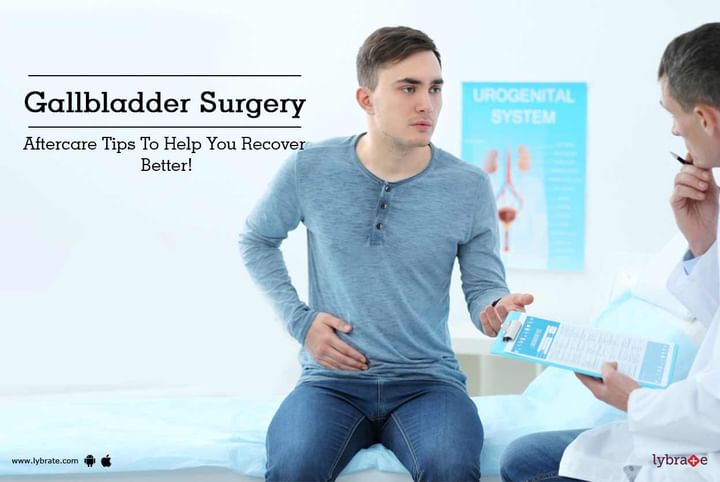Gallbladder Surgery - Aftercare Tips To Help You Recover Better!
Gall bladder is a very important digestive gland, which is located on the right side of your abdomen, just beneath your liver. Its main function is to collect, store and release bile, a digestive fluid produced in your liver, essential for metabolizing fats, into your small intestine.
Sometimes, small hard stones comprising of cholesterol, bile pigments and calcium salts in the shape of a pebble, can form in your gall bladder. Gallstones may cause no symptoms but when the gallstone lodges in ducts and blocks the flow of bile, it can cause persistent high-intensity pain which requires gallstone surgery.
Surgery is then prescribed to remove the gall bladder. This surgery is called cholecystectomy. It’s done when there are
- Gallstones in the gallbladder
- Gallstones in the bile duct
- Gallbladder inflammation
- Inflammation in pancreas
Gallstone surgery or cholecystectomy is a common surgery, and it comes with only a small risk of complications and you can walk out of the hospital on the day of the surgery itself.
Procedure
- Minimally invasive or laparoscopic cholecystectomy
- During this procedure, the surgeon makes 4 tiny incisions in your abdomen and inserts a tube with a tiny video camera inside it.
- Through a video monitor, the surgeon watches while he inserts surgical tools through the other 3 incisions to remove your gallbladder.
- After the surgery, the surgeon confirms that there are no gallstones left. Once this is done, he sutures your incisions and you are taken to the recovery area. A laparoscopic cholecystectomy takes just 2 hours or so.
- But the problem with this procedure is that it’ not appropriate for everyone. Sometimes, what happens is that, the surgeon may start with a laparoscopic surgery and then may decide to go for an open gallstone surgery because of scar tissue or complications.
- Traditional or open cholecystectomy
- This procedure requires a bigger incision of about 6-inches in your abdomen, below your ribs on the right side. The liver and gallbladder are exposed and the surgeon removes the gallbladder.
- An open cholecystectomy takes one or two hours.
Single-incision Laparoscopy Surgery
Traditional laparoscopic surgeries use a telescopic rod attached to a video camera called a laparoscope, which is inserted through a small incision. Apart from this, 3 to 5 additional small cuts are made to insert the other surgical instruments to perform the surgery.
However, single-incision laparoscopy surgery (SILS) is a revolutionary minimally invasive surgical procedure conducted through a single incision. It provides a better cosmetic outcome, as a small incision is made through the patient’s navel or belly button, resulting in an almost scarless outcome.
Indications
Most patients who are good candidates for laparoscopic surgery are eligible for single-port procedures. Some of the surgeries that single incision laparoscopy is indicated for include cholecystectomy (removal of gall bladder), appendectomy (removal of appendix), splenectomy (removal of spleen), hepatectomy (removal of liver) and adrenalectomy (removal of adrenal glands). SILS can also be used for diagnostic purposes.
However, patients who have previously undergone multiple major surgeries to the abdominal region and those who are morbidly obese are not considered for SILS.
Procedure
Single Incision Laparoscopy is usually performed as day surgery either in the hospital or outpatient surgery center under general, regional, or occasionally local anesthesia depending on the type of procedure performed and the surgeon’s preference.
The patient is made to lie down in a tilted position so that the feet are placed higher than the head. The surgeon makes a single incision of about 3/4th of an inch at the belly button and injects a harmless gas to expand the area and obtain a clear view of the operative site. A tube called a trocar or port is placed through the incision, through which the laparoscope (a narrow telescope having a light source and camera) and tiny surgical instruments are inserted. The laparoscope guides your surgeon with images of the abdominal contents that can be viewed on a large screen. Once the diseased organ is excised, your surgeon removes the instruments, releases the gas, and closes the incision with a small bandage.
Recovery
Common post-operative guidelines following Single Incision laparoscopy include the following:
- You will need someone to drive you home after you are released as the anesthesia may make you feel groggy and tired
- Do not remove the dressing over the incision for the first two days and keep the area clean and dry. No showering or bathing during this time. The incision usually heals in about 5 days
- Your surgeon may give you activity restrictions such as no heavy lifting. It is very important that you follow your surgeon’s instructions for a successful recovery
- You may feel soreness around the incision area. Your surgeon may give you a prescription pain medicine or recommend NSAID’s (non-steroidal anti-inflammatory drugs) for the first few days to keep you comfortable
- If the abdomen was distended with gas, you may experience discomfort in the abdomen, chest, or shoulder area for a couple days while the excess gas is being absorbed
You must be very careful with your diet after gallstone removal as your body will not be able to digest fats well. You will of course be sticking to a liquid diet for a week or two and then introduce solids back into your diet. When you do so, you have to stick to a low fat diet. Stay off fried foods and gas-forming foods. Also make sure that you consume no more than 60 gm of fats per meal to avoid discomfort. Stay off spicy foods to avoid bloats and abdominal pains. If you wish to discuss any specific problem, you can consult a general surgeon.



+1.svg)
